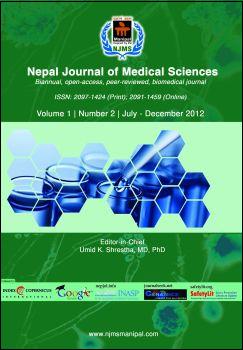Role of Cerebrospinal Fluid - Adenosine Deaminase Level in Early diagnosis of Various Etiologies of Meningitis in children
DOI:
https://doi.org/10.3126/njms.v1i2.6608Keywords:
Cerebrospinal fluid, adenosine deaminase, tubercular meningititsAbstract
Background: Determination of cerebrospinal fluid-adenosine deaminase (CSF-ADA) activity is a reliable means to differentiate tubercular from non- tubercular meningitis. This study was carried out to see the range with mean CSF-ADA levels in meningitis of various etiologies and to see if early diagnosis is possible based on these levels.
Methods: A prospective study of 140 children admitted in Manipal Teaching Hospital, from July 2009 – June 2011. Diagnosis was established by clinical findings and relevant investigations and patients were divided in different groups as pyogenic meningitis (PM), partially treated meningitis (PPM), tubercular meningitis (TBM), viral meningitis (VM) and controls. CSF-ADA estimation was done by using spectrophotometer.
Results: Out of total 140 patients, 103 were cases of meningitis and 37 were controls. There were 32 cases of PM, 27 cases of PPM, 34 cases of VM and 10 cases of TBM. The mean±SD with range of CSF-ADA was respectively 48±20.37 IU/L (20-70 IU/L), 14.57±6.48 IU/L (2-28 IU/L), 6.40±2.17 IU/L (3-9 IU/L), 8.29±10 IU/L (3-11 IU/L) and 5.27±2.69 IU/L (2-7 IU/L) in TBM, PM, PPM, VM and controls and the value was highest in TBM. The specificity, sensitivity, positive predictive value and negative predictive value of CSF-ADA for TBM were 94.6%, 100 %, 83.3% and 100%.
Conclusion: Estimation of ADA activity in CSF can be of great value in early diagnosis of tubercular meningitis. Furthermore it is a simple, reliable, relatively inexpensive test with easy procedure.
DOI: http://dx.doi.org/10.3126/njms.v1i2.6608
Nepal Journal of Medical Sciences. 2012;1(2): 97-102
Downloads
Downloads
Published
How to Cite
Issue
Section
License
Copyright © by Nepal Journal of Medical Sciences. The ideas and opinions expressed by authors of articles summarized, quoted, or published in full text in this Journal represents only opinions of authors and do not necessarily reflect the official policy of Nepal Journal of Medical Sciences or the institute with which the author(s) is (are) affiliated, unless so specified.




